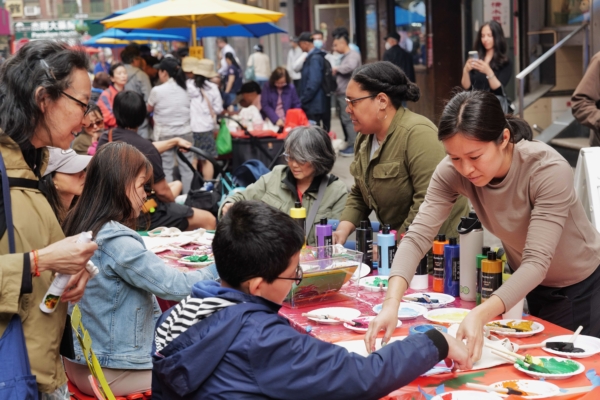On May 31st, Pell Street in Manhattan’s Chinatown was bustling with activity as the Asian Traditional Month event “Wellness in Place” hosted by the Chinatown BID took center stage. The street was filled with the aroma of street food and the sounds of music, showcasing a rich and diverse cultural atmosphere that attracted people of different ethnicities to gather on the open streets and join in the festivities.
Local food stalls were packed with visitors enjoying traditional delicacies, including newly introduced charcoal-grilled skewers and fruit-topped ice candies, which had people queuing up for a taste. On another corner, calligrapher Wang Xinren and poet/writer Tang Feng personally wrote traditional Chinese characters, captivating passersby who stopped to request and admire their work. Meanwhile, the children from the after-school program at the Manhattan Chinatown Public School’s Children’s Center (A Place for Kids) performed with innocence and aplomb, prompting onlookers to pull out their phones to capture the moment.
Event organizer and Executive Director of the Chinatown BID, Chen Zuozhou, highlighted that the musical performances were one of the highlights of the event. Traditional percussion instruments like the Hawaiian six-sided drum, barrel drums, and xylophones captivated the audience, while opera singer Aaron Loo showcased his talents. The performances by singers Napua Davoy and Keith Lane also received rounds of applause. Aaron Loo even brought a whimsical puppet show that was a hit with the children.
In addition to the outdoor activities, at the Chinese First Baptist Church on 21 Pell Street, a multimedia art project unveiling was held simultaneously. Artist Cheryl Wing-Zi Wong, with a background in architecture and public art, presented her three-and-a-half-year research project “Reflective Urbanisms: Mapping NY Chinatown,” which depicted the architectural and cultural stories of Chinatown since 1860 through changes in building facades, 3D maps, portraits, and oral histories.
“Our community has grown resilient, but today we still face the risk of marginalization and being forgotten,” Wong said. With the aging development of the community, their stories and memories may fade away, so she hopes that buildings can carry these stories and inspire people to cherish and pay attention to Chinatown’s history and culture.
Chen Zuozhou stated that the event aimed to allow people of all ethnicities to personally experience the unique and historic culture of New York’s Chinatown through a variety of vibrant Chinese cultural projects and to feel the vitality and cohesion of the community.

